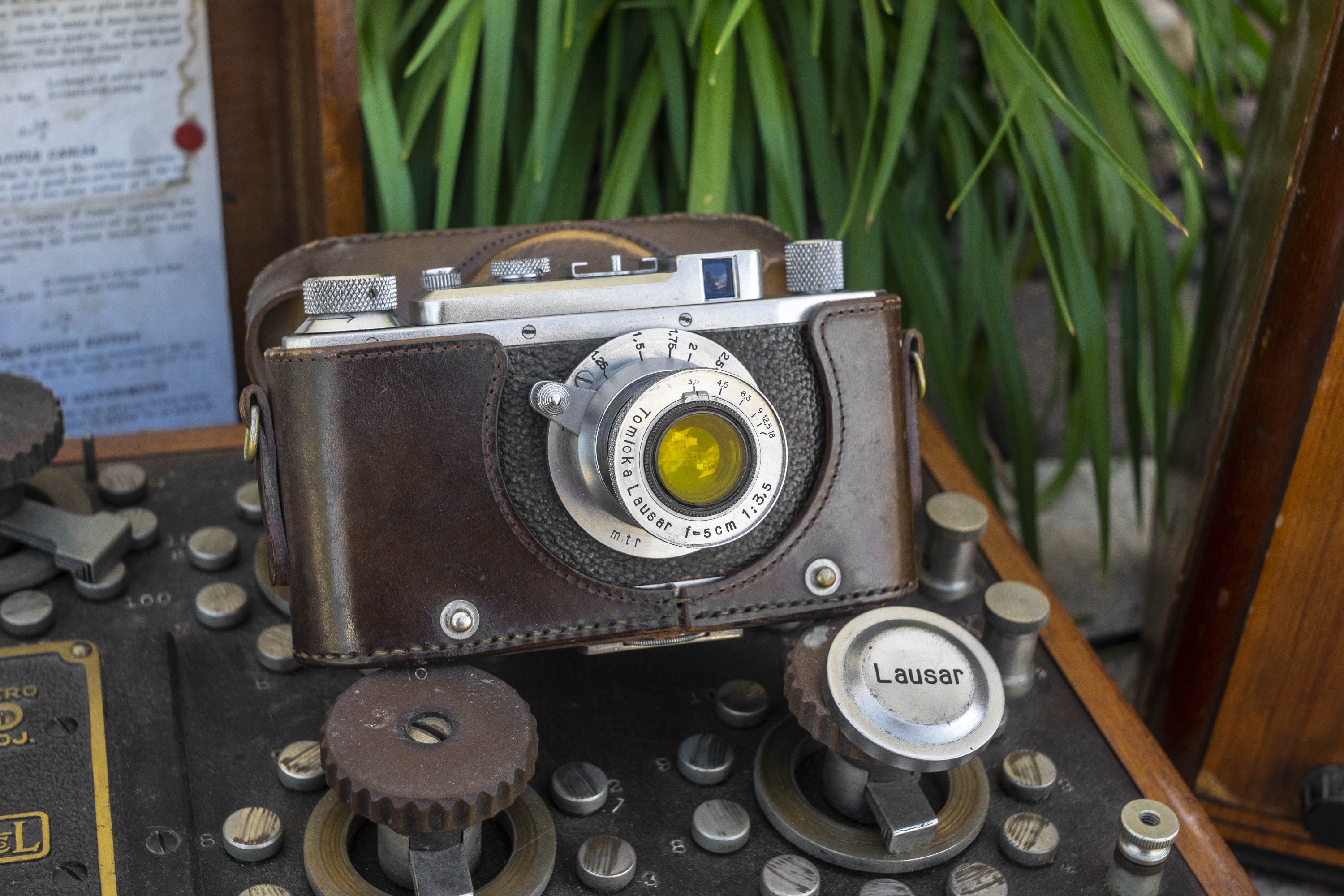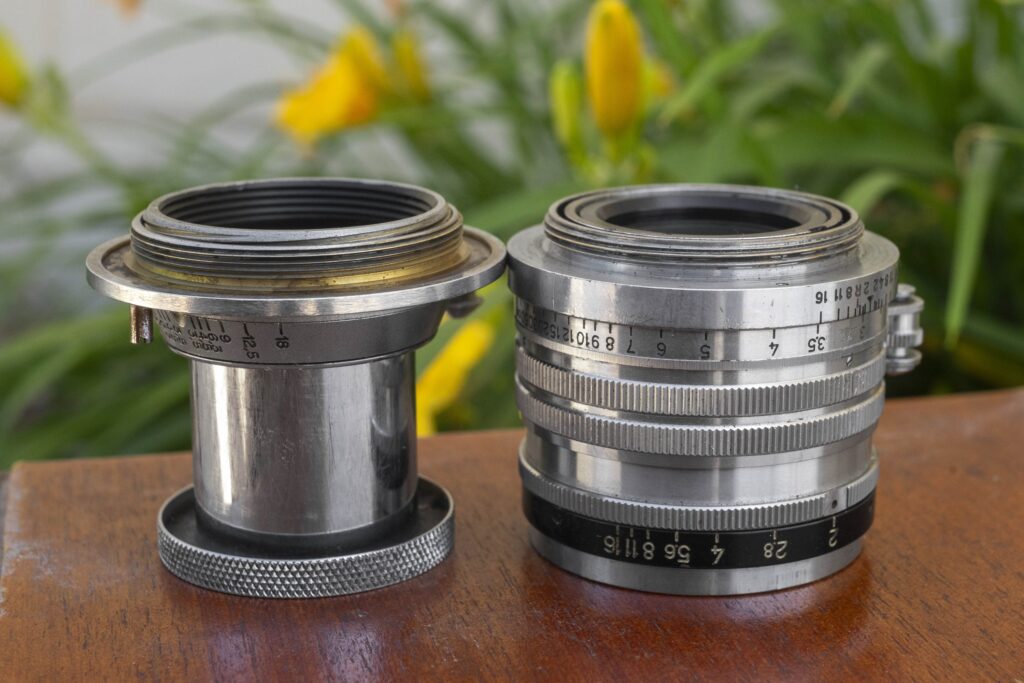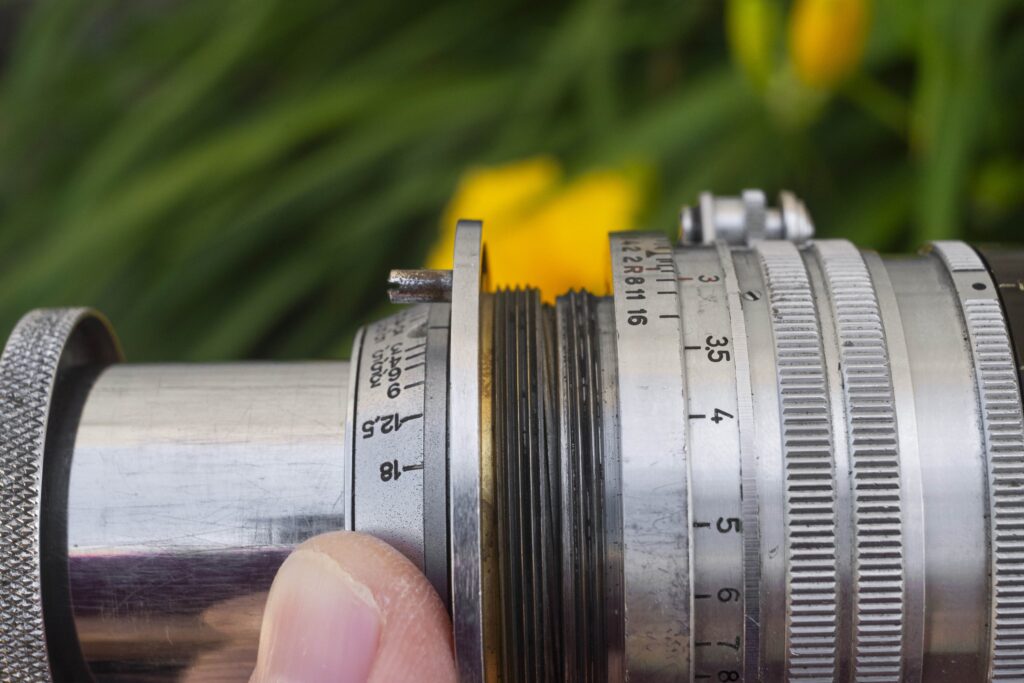This is a Tomioka Lausar, an interchangeable lens roll film camera made by Tomioka Kōgaku Kenkyūjo in Tokyo, Japan in 1937. The Lausar has a focal plane shutter and a body that is modeled to look like the Leica rangefinder, except it doesn’t have a rangefinder and it shoots 3cm x 4cm images on 127 format roll film. The Lausar is extremely rare with only 10 thought to have ever been made. It is nearly identical to another camera called the Baika, which is credited to a company called Sankyō Kōgaku. Both the Lausar and Baika are thought to be made by the same company, but the names engraved into both contradict this. With so few ever made and nearly no documentation surviving from the era in which they were made, very little else is known about these cameras.
Film Type: 127 Roll Film (twelve 3cm x 4cm exposures per roll)
Lens: 5cm f/3.5 Tomioka Lausar uncoated 4-elements
Lens Mount: 39mm Screw Mount (not Leica Thread Mount)
Focus: 1 meter to Infinity
Viewfinder: Scale Focus Optical Viewfinder
Shutter: Cloth Focal Plane
Speeds: Z (Bulb), 1/20 – 1/500 seconds
Exposure Meter: None
Battery: None
Flash Mount: None
Weight: 542 grams, 412 grams (body only)
Manual: None
Tomioka is a name often associated as a lens maker throughout a large part of the 20th century. The company produced a large number of lenses for Yashica cameras, and in 1968 was absorbed into the company, becoming a wholly owned subsidiary of Yashica.
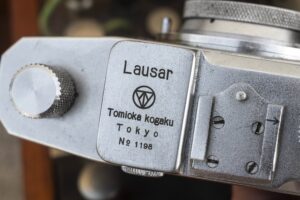
The company’s origins date back to 1924 when they were founded as Tomioka Kōgaku Kenkyūjo (Tomioka Optical Laboratory in English) by an ex Nippon Kogaku employee named Toshioka Masashige. While working for Nippon Kogaku, Toshioka Masashige produced lenses and other optical products exclusively for the military market. At the time, Germany was considered the leader of the optical industry and products made by Zeiss and other German firms were sought after by the Japanese military. In the 1920s, the German economy was decimated due to Germany’s loss in World War I, causing high unemployment. Nippon Kogaku leveraged unemployed optical engineers and enticed them to come work in Japan to help further their understanding of lens design. With the help of these ex-German engineers, Nippon Kogaku’s optical products advanced in quality quickly.
When he left Nippon Kogaku, Toshioka Masashige started Tomioka with the purpose of building civilian products for commercial sale. It is not exactly clear what the company did in its first several years, but by 1932 a manufacturing plant was opened in Ōmori-ku, Yukigaya where the first Lausar lenses were made. These lenses were likely produced for studio cameras and perhaps even some lenses for the Leica.
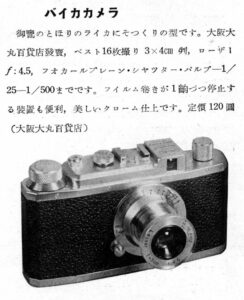
The mid 1930s saw tremendous growth of the Japanese photo industry as a large number of new companies like Seiki Kogaku (Canon), Chiyoda Kogaku (Minolta), and a large number of “First Camera Works” companies started producing cameras. It stands to reason that by the mid 1930s, Tomioka chose to enter the world of making cameras.
Their first effort would be revealed in 1937 as the Tomioka Lausar. The Lausar was an attractive camera that was built in the style of the German Leica which was extremely popular at the time. In addition to a similar body style, Tomioka’s new camera shared a cloth focal plane shutter and an interchangeable screw mount. Unlike the Leica however, the Lausar did not have a rangefinder and it made 3cm x 4cm images on 127 format roll film. In addition, although sharing a similar 39mm diameter threaded screw mount, the Lausar’s mount was not the same. Images showing a Lausar lens next to that of a typical Leica Thread Mount lens show that the Lausar’s threads have a finer pitch and go deeper into the lens mount. Any attempt to mount a Leica lens to the Lausar would result in damage to the threads.
The Tomioka Lausar appeared in Japanese trade publications throughout 1937 alongside an identical camera called the Baika whose engraving on the top plate of the camera says it was made by in Tokyo by a company called Sankyo Kogaku. This company is almost certainly Sankyō Kōgaku Kōgyō which like Tomioka, also produced lenses and had been around since 1929.
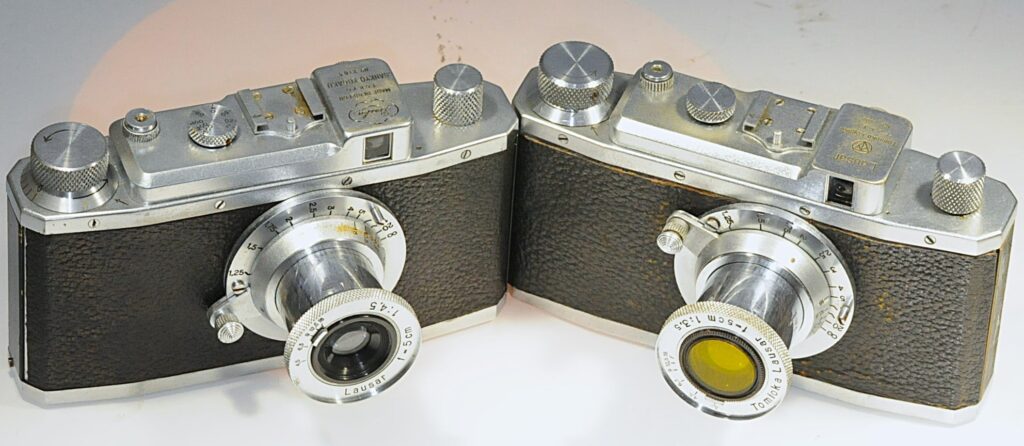
Although little information exists online about the production of the Tomioka Lausar or the Sankyo Kogaku Baika, the fact that the two cameras both appeared in 1937, and are externally identical other than the engravings and the lens shown on the prototypes, suggest that the same company made them. Whether Tomioka made them and rebadged them for Sanko Kogaku or the other way around is unknown.
We may never know the true history of who or why the Lausar and Baika were made, but that they were made is certain. It is estimated that only 10 of the Lausars were made and probably less than that of the Baika which decreases the chances of us ever learning a great deal more about them.
According to camera-wiki’s page about the two cameras, only 1 example of the Baika and 2 of the Lausar exist. Of the two Lausars, one has body serial number 1095 which sold at the Westlicht Auction in May 2013, and the other, serial number 1198 is here.
But wait, there’s more…
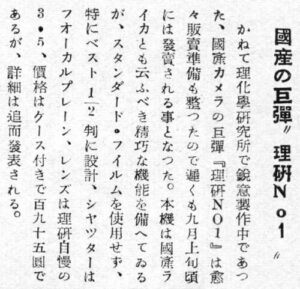
The story continues in August 1938 when a third company, Riken Kōgaku Kōgyō announced a camera called the Riken No.1 which looks very similar to the Lausar and Baika. Although at a glance the new camera looks the same as the Lausar and Baika, upon closer inspection the body molding is different as the new camera has more rounded edges and has a totally different shape to the raised viewfinder housing. Other small differences exist such as changes to the accessory shoe, the texture of the ring around the shutter release, the top plate has 3 screws in front compared to four, the spacing of the numbers on the exposure counter, and several other small details.
What is the same is that all three cameras use a cloth focal plane shutter with speeds from 1/20 to 1/500, they share the same interchangeable screw thread lens mount, and both have an automatic stop exposure counter.
The story of the Riken No. 1 was that the camera was available for presale before it was finished, and that problems with the film advance and perhaps the shutter required the company to cancel the camera and refund buyers their money.
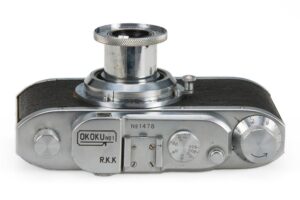
It would appear that the company would eventually work out the kinks and have an all new model, this time called the Gokoku ready for sale later in 1939. When it was released, the Gokoku looked exactly the same as the Riken No.1 prototype and nearly identical to the Lausar and Baika. Everything from the design of the shutter, shape of the body, location of its controls, and lens mount were the same. Unlike each of the Lausar, Baika, and Riken No.1 which never made it past the prototype stage, the Gokoku was produced for about a year, and while rare, is much easier to find. As I write this, one is for say on eBay for $1712. In 1940, a simpler camera called the Riken Ricohl would replace the Gokoku in Riken’s lineup.
The overall design of the Gokoku was popular in Japan as a large variety of similar solid body cameras which shoot 3cm x 4cm images on 127 roll film were made around the same time. At a glance, these cameras have an unmistakable resemblance to a Leica. Stare at it for more than a second however, and you’ll notice the absence of a rangefinder and that the camera is quite a bit larger than a 35mm Leica.

From the top down the Lausar hides its roll film roots with two knobs, one each on both sides. The larger knob on the right is the film advance with integrated exposure counter, and the smaller knob on the left is not what you think it is. Unlike most 35mm cameras which are designed to rewind film at the end of a roll, this is a roll film camera, which does not rewind film. Several sites online state that this knob doesn’t actually do anything, and without any sort of user manual to explain its purpose, it is a reasonable assumption to make, however it is not correct.
While the knob doesn’t actually rewind the film, it does move a tiny bit, and when you provide counterclockwise tension on it, the knob makes the supply spool beneath tight, stretching the film across the film gate, flattening it out. Film flatness was a big issue for many prewar Japanese roll film cameras, and if the film isn’t perfectly flat, you are guaranteed out of focus images. By using this knob to tighten the film, ensures the sharpest possible images.
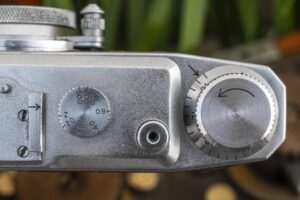
Other controls on the top plate work like you’d expect them to. There is a standard accessory shoe, shutter speed dial, and cable threaded shutter release. The shutter speed dial lifts up just like it does on most 35mm cameras of the era and has speeds from 1/20 to 1/500 plus Bulb, which is indicated by a Z. The exposure counter has an automatic stop feature, relying on a feeler shaft in the film compartment which detects movement of the film and automatically stops at the next frame. The exposure counter goes up to 12.

The base of the camera has two locking keys for accessing the film compartment. The design of these locks is another element taken from 35mm cameras like the Zeiss-Ikon Contax and Leica in which the keys also open and close metal reloadable cassettes inside the film compartment. Since the Lausar uses 127 film which has no cassette, these lock only serve the purpose for removing the bottom plate. In the center of the plate is a 3/8″ tripod socket, which was standard for German and Japanese cameras of the era.
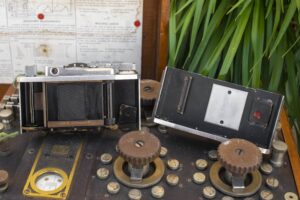
With the keys unlocked, the entire back and bottom of the camera comes off to reveal the film compartment. Other than the use of 127 film, this area of the camera also resembles a 35 camera with a cloth focal plane shutter and a ribbed shaft which advances the exposure counter. Film transports from left to right onto regular 127 spools. The bottom of each side of the camera has a hinged post which swivels down, making removal and installation of spools very easy.
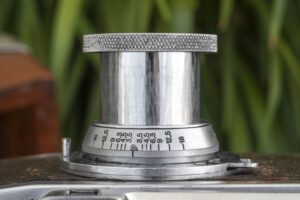
The 5cm f/3.5 Tomioka Lausar lens resembles the Leitz Elmar and almost certainly is a copy of it. That the Lausar camera shoots 3cm x 4cm images on 127 film is still within the image circle of a lens designed for 35mm film. Even if it is not a direct copy, Tomioka was a capable lens maker and it is entirely believable that the Elmar formula could have been tweaked for the larger film format. Considering how rare these cameras are and that more than one lens was made for them, means that detailed information about this specific lens may never be known.

Continuing on the list of things the Tomioka Lausar shares with a 35mm rangefinder, it also has a 39mm threaded lens mount. To the naked eye, the lens mount looks identical and some sites online suggest that LTM lenses can be used on this camera and that is not true. Although the Lausar shares the same 39mm diameter mount, the thread pitch is not the same, nor is the depth of the lens. When held side by side with a LTM lens, the images below show a clear difference in both the thickness of the threads, and how deep this lens mounts into the camera. Attempting to mount a LTM lens to this camera or vice versa will certainly damage the threads and should not be attempted. Like all screw mount cameras, removing the lens is a matter of rotating it counterclockwise and clockwise to put it back on. Had the Lausar been a more successful camera, additional lenses of different focal lengths would have been made, but as it stands, this is the only lens you’ll ever see on one.
The two images below show the 5cm f/3.5 Lausar lens (left) with an LTM Nikkor-HC 50mm f/2 lens (right). The Lausar uses a finer pitch thread which is deeper than the LTM lens.
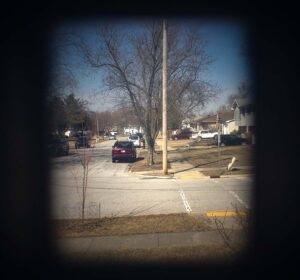
The Lausar viewfinder is a simple optical design with a front and rear piece of glass and nothing else. Despite its resemblance to a Leica rangefinder, there is no rangefinder, nor are there any projected or painted on frame lines, no parallax correction, and nothing about any other setting of the camera.
It is remarkable to me to what lengths Tomioka went to make this camera so much like the Leica, and get so close, but abandon the design. There is little to no information online about this, or the other cameras like the such as the Baika and other similar designs. That each of these were production ready cameras that disappeared as soon as they were built adds more to the mystery. The best explanation I can give you explains why so many Japanese cameras disappeared, or dramatically changed around 1937, which was the Second Sino-Japanese War with China in 1937. By the time production could have resumed, the preferences of the photographic community changed, rendering these cameras orphans in the history of the Japanese camera industry.
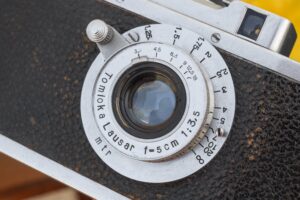
I came across this camera as a broker for a local seller near me who was selling it to another collector I know. Although the Tomioka Lausar appeared to be in good condition, my time with the camera was barely 24 hours and I needed to get it to its owner. Considering the rarity and value of the camera, I did not get a chance to shoot it, but suspect that the images it produced likely would have been on par with those I got from the Toa Koki Gelto DIII, so if you’re interested, you can see some sample images there.
During the brief time I had with the Tomioka Lausar, I took many photos of it as I figured they’d be useful for future collectors wanting to learn more about this camera. Below is a gallery of the remaining images that I couldn’t find room for in this review. In one of the images, the camera is in a leather case for the Riken Ricohl. While I do not believe this case is original to this camera, that it perfectly fits confirms the lineage of these cameras.
Related Posts You Might Enjoy
External Links
http://camera-wiki.org/wiki/Lausar_and_Baika
https://www.japancamerahunter.com/2012/02/the-tomioka-lausar/
https://www.leitz-auction.com/en/Tomioka-Kogaku-Tokyo-Lausar/AI-23-10395

